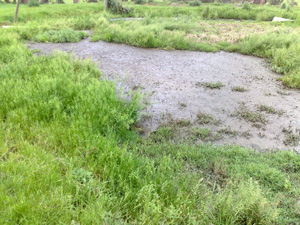For the last few weeks I’ve been visiting a dairy farm in West Gippsland to learn a bit more about how dairy farms work. It’s also an opportunity to apply some ideas about soil and water management in a practical context.
Cows can deposit around 8 – 10% of manure and urine output around the milking shed and yards. Manure and urine contains significant amounts of major nutrients including nitrogen, phosphorous and potassium.
On many farms this manure is often washed directly into specially contructed waste retention dams. A typical setup is a sedimentation dam sometimes followed by an aeration dam.

The picture shows a sedimentation dam on the WG farm. There is a thick crust of manure on top which means that conditions in the dam are most likely anaerobic. At this dam I didn’t want to get too close in case I became part of the waste system! Therefore I didn’t get a sample!
In an anaerobic dam the organic matter itself provides oxygen to help drive the other processes that eventually break down most of the organic matter into methane, hydrogen, carbon dioxide and ammonia. But the disadvantage of this method is that energy in the organic matter is lost (as methane) and importantly nitrogen is lost (as ammonia).
The overflow from the sedimentation dam on the farm enters a second aeration dam. What can we expect the water quality to be in this type of dam? There shouldn’t be much nitrogen but what other nutrients will be present?

The aeration dam is just below the sedimentation dam. The overflow pipe can be seen in the picture. The water has a brown colour and a slightly unpleasant smell. Here are some water quality tests done in the Apps Labs lab: Dissociated carbon dioxide 13.5 ppm (elevated); Turbidity (unfiltered) 57 FTU (high); Turbidity filtered (0.45 micron) 19.8 FTU (still high); pH 7.1 (very slightly on the alkaline side); UV absorbance 99.2% (very high dissolved humic materials); Conductivity 1459 microS/cm (elevated salts); redox potential (ORP) -44.7 mV (anaerobic, and that’s at the surface).
Nitrate and nitrite were checked using screening tests. Both were at low levels or absent. That’s expected anyway because nitrates usually don’t exist in low oxygen conditions and nitrites usually form from nitrates under reducing conditions. Phosphate was checked using two different test kits. One showed phosphate over 30 ppm. The other showed phosphate as 43 ppm. Both these levels are very high.
There may be significantly more phosphate present in the two dams than the amount measured as some is likely to be held in the sediments.
What about nitrogen? Ammonia – nitrogen in the aeration dam was 0.44 ppm. This is higher than normally found in natural waters but is not excessive. At pH 7 around 0.4% of this nitrogen can be expected to be in the ammonia form as opposed to the ammonium form. This is not good for water life because the ammonia form is harmful. In general as water becomes more alkaline, an increasing amount of any total ammonia nitrogen present is likely to be in the ammonia form. This same amount of ammonia nitrogen, is roughly equivalent to 2 ppm nitrogen as nitrate. This is slightly elevated for natural waters so the nitrogen in the ammonia form probably doesn’t account for all the nitrogen in the original manure entering the two dams.
What is the best way to use dairy effluent to capture maximum nutrient value?
The following web resource provides detailed figures on tests done on dairy effluent dams and suggests way to reuse the nutrients in the effluent:
DPI Victoria 2013, Using dairy effluent as a fertilizer. Downloaded from http://www.dpi.vic.gov.au/agriculture/dairy/pastures-management/fertilising-dairy-pastures/chapter-13, November 2013.